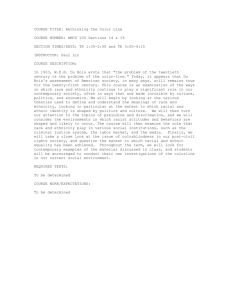- Gallagher Rethinking The Color Line
- Rethinking The Color Line 5th Ed
- Rethinking The Color Line Sixth Edition

Overview

User-friendly without sacrificing intellectual or theoretical rigor, this anthology of current research examines contemporary issues and explores new approaches to the study of race and ethnic relations. The featured readings effectively engage students by helping them understand theories and concepts. Active learning in the classroom is encouraged while providing relevance for students from all ethnic, cultural, and economic backgrounds. The fifth edition features ten new articles on such timely topics as:
• The U.S. Census’ changing definition of race and ethnicity
• Race-based disparities in health
• Racial and gender discrimination among racial minorities and women
• Being Arab and American
• How social control maintains racial inequality
• The increase in black and brown incarceration
• How racial bias may affect the use of DNA to locate suspects of crimes
• How derogatory ethnic and racial images are created and disseminated by the media
• The sexualization of African American women through the use of gender stereotypes
• The portrayal of light- and dark-skinned biracial characters
Gallagher Rethinking The Color Line
Rethinking the Color Line is a user-friendly text that does not sacrifice intellectual or theoretical rigor. This anthology of current research examines contemporary issues and explores new approaches to the study of race and ethnic relations. Rethinking the Color Line helps make sense of how race and ethnicity influence aspects of social life in ways that are often made invisible by culture, politics, and economics.
Rethinking The Color Line 5th Ed
Rethinking The Color Line Sixth Edition
Question No.1: Defining Race: Comparative Perspectives
a) Hypodescent Status:
This term refers to the assignment of individuals belonging to mixed race or ethnic groups to subordinate groups. This ideology usually exists in a society where certain groups are considered to be dominant or superior to the others. According to the view of F. James Davis in 'Defining Race: Comparative perspectives', hypodescent status refers to the social position of the mix breeds of white and black.
The very concept of hypodescent status is based on 'one-drop rule'. The theory presents an idea that whosoever has a single drop of a black man's blood in him is a black man himself. This makes every individual who has one of his parents as 'black' or either is considered to have any trace of African descent, a hypodescent. The term has been coined by anthropologists and refers to hypodescents as members of subordinate groups in the society. It is important to note that one-drop rule strictly refers to having a black ancestry. And, black people are the ones who bear any black African lineage, not the ones from unmixed population from Sub-Saharan Africa (Gallagher 54).
It is important to note that the concept of hypodescents only exists in United States, not in any other part of the world and is used to refer to American blacks only, which makes this term and the one-drop rule, rather unique.. In fact, definitions of who is black vary quite